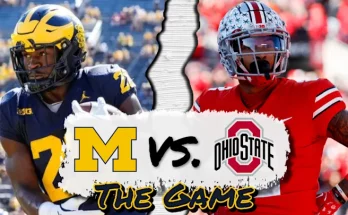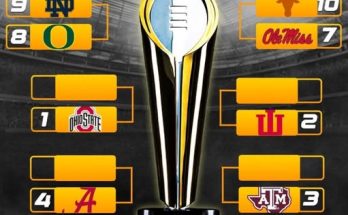Scarlet and Gray Forever: Ohio State Becomes the First Program in History with 1,000 AP Poll Appearances — A Legacy of Greatness Etched in Every Era
From the moment the Associated Press Poll was first introduced in 1936, college football has used its rankings as a barometer of greatness—a reflection not only of wins and losses, but of legacy, tradition, and sustained excellence. Now, nearly nine decades later, one program stands alone at the pinnacle of consistency and dominance. The Ohio State Buckeyes have become the first team in college football history to appear in the AP Poll 1,000 times, etching their name in the record books and reaffirming their position as one of the sport’s most iconic dynasties.
For generations of fans clad in scarlet and gray, this milestone is more than just a number. It is the living embodiment of Ohio State’s enduring commitment to excellence, a symbol of pride passed down from Woody Hayes to Urban Meyer to Ryan Day. It tells a story of relentless pursuit, unbreakable culture, and a standard so high that it has shaped the very identity of college football itself.
Since its inception, the AP Poll has chronicled the ever-shifting tides of the sport—dominant dynasties, Cinderella stories, and legendary rivalries. Yet through it all, Ohio State has remained a constant presence, a steady beacon of dominance in the heart of the Big Ten. Their 1,000th appearance is not just a reflection of their winning seasons but of their sustained relevance in every era, across changing times, coaches, and challenges. From the bruising days of Hayes’s ground-and-pound football to the high-octane offenses of Meyer and Day, the Buckeyes have evolved without ever losing their essence—winning with purpose, playing with pride, and inspiring generations.
The Buckeyes’ first appearance in the AP Poll came in the very first year of its existence—1936. Back then, the landscape of college football looked nothing like it does today. Stadiums were smaller, the game slower, and the sport still emerging into the national spotlight. Yet even then, Ohio State was already a name that resonated beyond the Midwest. That early recognition was a sign of what was to come: a program built not just to succeed but to endure.
Throughout the 1940s and 1950s, the Buckeyes began to define their identity. Under coach Paul Brown, and later under Woody Hayes, they became a powerhouse that combined toughness with discipline. Hayes, the larger-than-life figure who would come to define Ohio State football for a generation, turned the Buckeyes into a national brand. His famous mantra, “You win with people,” became the cornerstone of a culture that emphasized character as much as talent. Between 1951 and 1978, Hayes guided Ohio State to five national championships and 13 Big Ten titles, establishing the foundation of what would become one of the most dominant programs in sports history.
During the Hayes era, the Buckeyes not only won—they embodied the spirit of the Midwest. They were blue-collar yet elite, disciplined yet daring. Every Saturday in Columbus became a celebration of tradition, with the team dotting the “i” in Script Ohio, the crowd roaring in unison, and the band blaring “Across the Field.” It was football as ritual, sport as identity. And as Ohio State rose, so too did its legend.
In the decades that followed, the Buckeyes faced challenges—coaching changes, NCAA investigations, heart-breaking losses—but through it all, their standard never wavered. In the 1980s and 1990s, under coaches Earle Bruce and John Cooper, the program continued to recruit elite talent and remain a fixture in the national rankings. Names like Chris Spielman, Eddie George, and Orlando Pace became synonymous with excellence, players who embodied both the grit and grace that define Buckeye football.
The 2000s ushered in a new era of dominance under Jim Tressel. With his trademark sweater vest and calm demeanor, Tressel brought a sense of order and precision that mirrored the program’s values. His tenure was marked by unforgettable moments: the 2002 national championship victory over Miami, one of the most dramatic games in college football history, and a string of Big Ten titles that reestablished Ohio State as the conference’s premier power. The Buckeyes were back on top, and the AP Poll reflected their sustained dominance week after week, year after year.
When Urban Meyer took the reins in 2012, he inherited greatness—and elevated it even further. Meyer’s Buckeyes were fast, fearless, and relentless. They dominated opponents with a blend of power and speed that reflected the evolution of the modern game. The 2014 national championship team, led by Ezekiel Elliott, Joey Bosa, and a trio of quarterbacks that included J.T. Barrett, Cardale Jones, and Braxton Miller, became one of the most iconic squads in college football history. Their stunning playoff run—culminating in a rout of Oregon—was the perfect blend of old-school grit and new-age explosiveness. Meyer’s tenure not only kept the Buckeyes atop the polls but also ensured that a new generation of fans grew up knowing Ohio State as the benchmark of success.
Today, under Ryan Day, the Buckeyes remain as formidable as ever. Day, a coach who blends tactical brilliance with emotional intelligence, has carried the torch with respect for the past and vision for the future. His teams have maintained their place among the nation’s elite, consistently appearing near the top of the AP Poll. Even as college football evolves—with NIL deals, transfer portals, and expanded playoffs—Ohio State continues to thrive. The program has adapted to every new challenge without losing sight of what has always made it great: preparation, precision, and pride.
Reaching 1,000 AP Poll appearances is not an accident of longevity—it is the byproduct of excellence repeated over generations. Only a select few programs can even dream of such consistency. For comparison, Alabama, another titan of college football, trails Ohio State by nearly a hundred appearances, while other storied programs like Oklahoma, Notre Dame, and Michigan sit even further behind. This speaks not just to Ohio State’s success but to its remarkable stability. In an era when even the most powerful teams go through cycles of rise and fall, the Buckeyes have remained steadfast. They are not just part of college football history—they are its living heartbeat.
Every appearance in the AP Poll tells a piece of a larger story. It tells of teams that dominated their rivals, of players who became legends, of moments that defined eras. Archie Griffin, the only two-time Heisman Trophy winner in history, carried the Buckeyes through the 1970s with unmatched grace and consistency. Troy Smith’s electrifying 2006 season, culminating in a Heisman win, reminded fans of the program’s ability to produce stars on the grandest stage. In recent years, C.J. Stroud, Marvin Harrison Jr., and other modern greats have continued the lineage of excellence, each adding their own chapter to the Buckeye legacy.
But beyond the individual stars and championship trophies, what truly sets Ohio State apart is the culture that underpins it all. Every player who dons the scarlet and gray is taught that they are part of something bigger than themselves—a brotherhood that stretches back nearly a century. The “Buckeye way” is not a slogan; it’s a mindset, a shared belief that hard work, unity, and discipline will always prevail. That ethos has carried the program through triumphs and trials alike, binding generations of players and fans together in a shared story of perseverance and pride.
For the fans, this milestone is deeply personal. From the raucous crowds at Ohio Stadium—the “Horseshoe”—to Buckeye bars across the country, every appearance in the AP Poll has been a point of pride. It’s not just about being ranked; it’s about belonging to something eternal. To be an Ohio State fan is to inherit a tradition that transcends wins and losses. It’s to understand that every Saturday in the fall is part of a larger legacy, one that began long before you and will continue long after.
And that is what makes the 1,000th appearance so special. It’s not a destination but a continuation—a new chapter in a story that refuses to end. In a sport that has seen dynasties rise and fall, Ohio State remains a constant. Whether it’s under the golden glow of autumn Saturdays or the bright lights of national championship games, the Buckeyes continue to define what greatness looks like.
As the AP Poll evolves and college football continues to change, Ohio State’s place in the game’s lore is secure. The milestone is a testament not just to the program’s success but to its soul—to the players who gave their all, the coaches who demanded the best, and the fans who believed through every high and low. It is proof that excellence, when built on integrity and tradition, can withstand the test of time.
“Scarlet and Gray Forever” is more than a slogan—it’s a promise. A promise that no matter how the game changes, the spirit of Ohio State football will endure. A promise that every Saturday, when the band strikes up “Carmen Ohio” and the team takes the field, the past and present come together in one unbroken chain of greatness. A promise that as long as college football exists, the Buckeyes will be there—ranked, revered, and relentless.
A thousand appearances in the AP Poll. A thousand moments of pride. A thousand reminders of what it means to be a Buckeye. The numbers tell the story, but the legacy speaks louder still: Ohio State doesn’t just play football—they define it. And as history continues to unfold, one thing remains certain—the scarlet and gray will shine forever.



